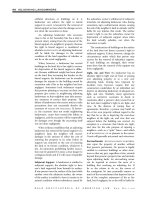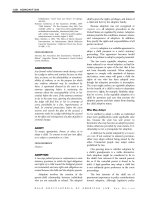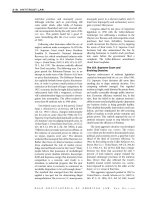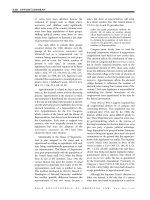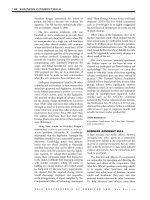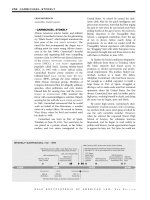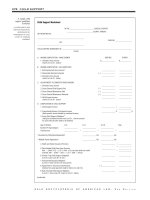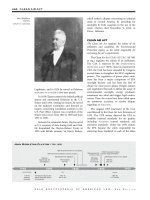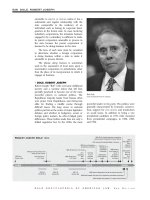Gale Encyclopedia Of American Law 3Rd Edition Volume 3 P36 potx
Bạn đang xem bản rút gọn của tài liệu. Xem và tải ngay bản đầy đủ của tài liệu tại đây (328.66 KB, 10 trang )
Since Miranda was decided, state and federal
courts have struggled with a number of issues
with regard to its application, including: when a
suspect is deemed to be in custody and thus
entitled to the warnings required by Miranda;
and when a suspect will be deemed to have
waived the right to have an attorney present
during questioning. Some recent decisions by
the U.S. Supreme Court have attempted to
answer these difficult questions.
In Stansb ury v. California, 511 U.S. 318, 114
S. Ct. 1526, 128 L. Ed. 2d 293 (1994), the Court
considered whether a police officer’s subjective
and undisclosed opinion concerning whether a
person who had been questioned had been a
suspect was relevant in determining whether
that person had been in custody and thus
entitled to the Miranda warnings. In 1982
Robert Stansbury was convicted of first-degree
MURDER, RAPE , KIDNAPPING, and a lewd act on a
child under the age of 14. The morning after
ten-year-old Robyn Jackson had disappeared
from a Baldwin Park, California, playground, a
witness in Pasadena, California, had observed a
large man leaving a turquoise car and throwing
something into a nearby flood-control channel.
The witness called the police, who discovered
Jackson’s body in the channel. She had been
raped, strangled, and struck on the head with a
blunt instrument. The police later learned that
Jackson had talked to two ice-cream truck
drivers, one of whom was Stansbury, shortly
before she disappeared. Officers went to
Stansbury’s home and asked Stansbury to go
to the police station to answer some questions
concerning their investigation into Jackson’s
murder. Stansbury agreed and accepted a ride to
the station in a police car.
At the police station, Stansbury was ques-
tioned about his whereabouts and activities on
the day Jackson’s body was discovered. The
police did not read him the Miranda warnings
at the time. Stansbury told the police that he
had talked to the girl, that he had returned to
his trailer a few hours later, and that he had left
around midnight in his roommate’s turquoise
car. The car matched the description given by
the witness. Stansbury also admitted that he
previously had been convicted of rape, kidnap-
ping, and
CHILD MOLESTATION. The detective
interviewing Stansbury then terminated the
conversation and read Stansbury the Miranda
warnings. Stansbury was later charged with
first-degree murder and other crimes.
At a
PRETRIAL CONFERENCE, Stansbury moved
to suppress all of the statements that he had
made at the station, as well as the evidence that
had been discovered as a result of those
statements. The trial court denied his motion,
ruling that Stansbury had not been in custody—
and thus that he had not been entitled to the
Miranda warnings—until he had mentioned the
turquoise car. Before that point in the interview,
the court reasoned, Stansbury had not been
considered a suspect. Based on that conclusion,
the trial court permitted introduction of the
statements that Stansbury had made before he
had mentioned the car. Stansbury was convicted
on all charges and was sentenced to death for
first-degree murder.
On appeal, the California Supreme Court
affirmed Stansbury’s conviction, rejecting the
“in-custody” claim that he had raised in the trial
court. The state supreme court, applying an in-
custody legal standard based on whether the
investigation has focused on the subject, agreed
with the trial court’s conclusion that suspicion
had focused on Stansbury only after he
mentioned driving the turquoise car on the
night of the crime. Therefore, the court held,
Stansbury had not been subject to custodial
interrogation before that time, and in turn
Miranda warnings had not been required, and
his statements were admissible.
The U.S. Supreme Court reversed and
remanded the case. In a
PER CURIAM decision
After a person has
been taken into
custody by law
enforcement officials,
he must be advised of
his constitutional
rights before the
officals begin an
interrogation.
AP IMAGES
GALE ENCYCLOPEDIA OF AMERICAN LAW, 3
RD E DITION
338 CUSTODIAL INTERROGATION
(a brief, unanimous, and unsigned opinion), the
Court held that “an officer’s subjective and
undisclosed view concerning whether the per-
son being interrogated is a suspect is irrelevant
to the assessment [of] whether the person is in
custody.” Instead, according to the Court, the
key inquiry should be whether the individual
had been placed under formal arrest, or whether
the restraint placed on the individual’s freedom
of movement rose to the level of a formal arrest.
The Court further noted that the “initial
determination of custody depends on the
objective circumstances of the interrogation,
not on the subjective views harbored by either
the interrogation officers or the person being
questioned.” So long as an officer’s subjective
view that an individual being questioned is a
suspect is not disclosed to the individual, the
officer’s view has no bearing on the in-custody
issue. If the officer’s knowledge or beliefs are
communicated to the individual being ques-
tioned, the Court stated, that knowledge
or those beliefs are relevant only to the extent
that the individual “would gauge the breadth of
his or her ‘freedom of action.’” But a statement
from the officer that the individual is the prime
suspect, in and of itself, is not “dispositive of the
custody issue.”
In Stansbury, the California Supreme Court
had not analyzed the in-custody issue based on
these principles. Thus, the U.S. Supreme Court
remanded the case to the trial court to
determine whether the objective facts surround-
ing Stansbury’s interrogation supported the trial
court’s original conclusion that Stansbury had
not been in custody before he mentioned the
turquoise car.
The high court tackled another difficult
Miranda issue in Davis v. United States, 512 U.S.
452, 114 S. Ct. 2350, 129 L. Ed. 2d (1994 ), when
it considered the circumstances under which a
suspect who was subject to custodial interro-
gation has validly waived the right to have an
attorney present during questioning. In an
earlier decision, Edwards v. Arizona, 451 U.S.
477, 101 S. Ct. 1880, 68 L. Ed. 2d 378 (1981),
the Court had held that such a waiver must be
“knowing and intelligent.” Furthermore, the
Court had made clear in Edwards that police
officers must immediately stop questioning a
suspect who clearly asserts the right to have
legal counsel present during the interrogation.
Edwards applied only when a suspect
clearly asserted the right to have counsel
present; it did not provide guidance to officers
when a suspect made an ambiguou s or
equivocal request for counsel. A ddressing that
situation, some jurisdictions had held that any
mention of counsel, no matter h ow ambigu-
ous, required that questioning cease. Other
courts had attempted to defin e a threshold
standard of clarity, under which comments
that fell below the required clarity did not
invoke the
RIGHT TO COUNSEL.Stillother
jurisdictions had ruled that questioning must
cease upon any mention of counsel, but
officers were permitted to ask further, narrow
questions to clarify whether the suspect desired
an attorney. In Davis, the U.S. Sup reme Court
settled the issue, holding that officers are
not required to cease questioning if a suspect
makes an ambiguous request for counsel.
Questioning m ay continue until the suspect
makes an “unambiguous” request for an
attorney. Furthermore, the Court held, police
officers have no d uty to seek clarification of an
ambiguous request.
The case began when Robert Davis, a
member of the U.S. Navy, became a suspect in
the murder of another sailor at the Charleston,
South Carolina, naval base. Davis was inter-
viewed by the authorities and informed of his
Miranda rights. He waived, orally and in
writing, his right to remain silent and his right
to counsel. But after talking w ith agents for 90
minutes, he stated, “Maybe I should talk to a
lawyer.” One of the agents asked Davis whether
he wanted an attorney, or whether he was just
making a comment. Davis replied, “No, I’m not
asking for a lawyer.” After a short break, the
agents reminded him of his right to remain
silent and then resumed the questioning. An
hour later, Davis said, “I think I want a lawyer
before I say anything else.” The agents then
stopped the interview.
At his general
COURT-MARTIAL, Davis main-
tained that the statements made during the
interview after his ambiguous statement con-
cerning the need to talk with a law yer should
not be admitted. The court ruled that the
ambiguous statement had not been in the form
of a request fo r an attorney, and thus the
statements made after it were admissible. Davis
was found guilty of unpremeditated murder and
sentenced to life imprisonment. His conviction
was affirmed by the military appellate court.
The U.S. Supreme Court also affirmed the
conviction. Writing for the majority, Justice
GALE ENCYCLOPEDIA OF AMERICAN LAW, 3RD E DITION
CUSTODIAL INTERROGATION 339
Sandra Day O’Connor noted that none of the
Court’s previous decisions addressing Miranda
issues required that questioning of a suspect
be terminated if the suspect makes an ambigu-
ous or equivocal request for counsel. To gain
Miranda protection, she maintained, a suspect
must “unambiguously request counsel,” and the
request must “articulate [the suspect’s] desire to
have counsel present sufficiently clearly that a
reasonable police officer in the circumstances
would understand the statement to be a request
for an attorney.” She further stated that
requiring questioning to stop when a suspect
makes ambiguous references to requesting an
attorney would transform the Miranda protec-
tions into “wholly irrational obstacles to legiti-
mate police investigative activity.” Police offi-
cers, she main tained, would be forced to end
questioning even if the suspect does not want an
attorney, thus hampering effective law enforce-
ment. Permitting a mere reference to an
attorney to end an interrogation would require
police officers to “make difficult judgment calls
whether the suspect in fact wants a lawyer even
though he hasn’t said so, with the threat of
supression if they guess wrong.”
In a separate opinion, Justice
DAVID H.
SOUTER, joined by Justices HARRY A. BLACKMUN,
JOHN PAUL STEVENS,andRUTH BADER GINSBURG,
concurred in the judgment affirming Davis’s
conviction. In Souter’sview,officerscould
constitutionally pose questions to clarify a
suspect’s ambiguous reference for counsel, as
was done in Davis. Souter believed that the
statements given by Davis, after the counsel
issue w as clarified, indicated that Davis did
not want an attorney. Nevertheless, Souter
disagreed with the Court’s rulin g that the
agents could entirely disregard Davis’s refer-
ences to wanting one. He argued that, l ike
the agents in Davis, the Court should adopt
a rule barring officers from further que stioning
until they have determined whether a suspect’s
ambiguous statement was meant as a request
for an attorney. According to Souter, a “timid
or verbally inept subject” might not under-
standwhatisrequiredinorderforhimor
her to stop the interrogation and to consult
with an attorney. If the suspect understands
that a request has b een ignored, he or she m ay
not object further and may see “confession
(trueornot)astheonlywaytoend[ the ]
interrogation.”
The Future of Miranda
Miranda and its progeny have long served as a
whipping post for politicians, legal commenta-
tors, and others who perceive the decision as
“coddling criminals.” They argue that the
Miranda warnings impede police officers from
efficiently and effectively doing their jobs by
adding additional layers of unnecessary proce-
dure to the law enforcement process. Miranda
critics also maintain that the police are
punished, and that society is harmed, when
defendants are set free, because key evidence is
suppressed after being obtained in violation of
the Fifth Amendment’s prohibition against un-
Mirandized confessions. Moreover, Miranda
critics contend that criminal suspects seldom
fully understand the meaning or importance of
the rights recited to them. Finally, critics cite
studies indicating that the Miranda decision has
had little effect in reducing the number of
confessions and requests for lawyers made by
suspects in custody.
In 1999 the U.S. Court of Appeals for the
Fourth Circuit fueled long-standing speculation
that Miranda would be overruled when it held
that the admissibility of confessions in federal
court is governed not by Miranda, but by a
federal statute enacted two years after Miranda.
The statute, 18 U.S.C.A. § 3501, provides that a
CONFESSION is admissible if voluntarily given,
with the voluntariness of each confession being
evaluated by the “totality of the circumstances”
on a cases-by-case basis, without any require-
ment that the
DEFENDANT be Mirandized.
Congress enacted the statute to overturn
Miranda, the Fourth Circuit wrote, and Con-
gress had the authority to do so pursuant to its
authority to overrule judicially created rules of
evidence that are not mandated by the Consti-
tution (United States v. Dickerson, 166 F.3d 667
[4th Cir. 1999]).
The U.S. Supreme Court reversed. In a 7–2
opinion authored by Chief Justice
WILLIAM
REHNQUIST
, the Court wrote that whether or
not it agreed with Miranda, the principles of
STARE DECISIS weigh heavily against overruling it
then. Whereas the Court has overruled other
precedents when subsequent cases have under-
mined their doctrinal underpinnings, that has
not happened to the Miranda decision, which
the Court said “has become embedded in
routine police practice to the point where the
warnings have become part of our national
GALE ENCYCLOPEDIA OF AMERICAN LAW, 3RD E DITION
340 CUSTODIAL INTERROGATION
culture.” Although a few guilty defendants may
sometimes go free as the result of the applica-
tion of the Miranda rule, the Court observed,
experience shows that the totality-of-the-
circumstances test set forth in Section 3501 is
more difficult than Miranda for law enforce-
ment officers and courts to apply in a consistent
manner (Dickerson v. Un ited States, 530 U.S.
428, 120 S. Ct. 2326, 147 L. Ed. 2d 405 [2000]).
The Court said that a contrary conclusion is
not required by the fact that it has subsequently
made exceptions to the Miranda rule. No
constitutional rule is immutable, much less
immune from the sort of refinements Mirand a
has undergone to adapt to the needs and
realities of law enforcement. Moreover, the
Court emphasized, these exceptions have re-
duced some of the law enforcement inefficien-
cies that Miranda critics were predicting would
undermine the efficiency of criminal investiga-
tions, as the Miranda warnings are now often
provided in a rote and perfunctory manner
during arrest and custodial interrogation. “If
anything,” Rehnquist wrote, “subsequent cases
have reduced the impact of the Miranda rule on
legitimate law enforcement while reaffirming
the decision’s core ruling that unwarned state-
ments may not be used as evidence in the
prosecution’s case in chief.”
Dickerson surprised many observers, not
only because the Court declined to overrule
Miranda, but also because Chief Justice William
Rehnquist authored the opinion upholding
Miranda, even suggesting that Miranda had
become so “embedded” in the nation’s juris-
prudence as to be unlikely to be overturned in
the foreseeable future. Most observers consider
Rehnquist to be one of the Court’s more
conservative members. His opinions are fre-
quently joined by fellow conservatives, Justices
ANTONIN SCALIA and CLARENCE THOMAS, both of
whom dissented in Dickerson. On any numb er
of other issues, civil libertarians have assailed
the chief justice for what they regard as his
narrow reading of the
BILL OF RIGHTS. Dickerson
both tempered that criticism and quieted
speculation about the future of Miranda.
FURTHER READINGS
Clymer, Steven D. 2002. “Are Police Free to Disregard
Miranda?” Yale Law Journal 112:3 (December).
Kenney, Jack. 1998. “Custodial Interrogation, Invocation
of Right to Counsel.” Res Gestae 42 (November–
December).
Pearce, Gene A. 2001. “Constitutional Law—Criminal Law:
The United States Supreme Court Affirms the Use of
Miranda Rights by Police to Determine the Admissibil-
ity of Statements Made during Custodial Interro-
gation.” North Dakota Law Review 77 (winter).
CROSS REFERENCES
Criminal Procedure; Privilege Against Self-Incrimination;
Right to Counsel; Self-Incriminat ion.
CUSTODY
The care, possession, and control of a thing or
person. The retention, inspection, guarding,
maintenance, or security of a thing within the
immediate care and co ntrol of the person to whom
it is committed. The detention of a person by
lawful authority or process.
For example, in a
BAILMENT,theBAILEE has
custody of goods delivered to him or her in
trust for the execution of a special object upon
such goods.
The term is flexible and may mean actual
imprisonment or the me re power—legal or
physical—of imprisoning or assuming manual
possession. A petitioner must be “in custody” to
be entitled to
HABEAS CORPUS relief, which
provides for release from unlawful confinement
in violation of constitutional rights. Custody in
this context is synonymous with restraint of
liberty and does not necessarily mean actual
physical imprisonment. Persons who are on
PROBATION or who are released on their own
recognizance are “in custody” for purposes of
habeas corpus proceedings.
CHILD CUSTODY, which encompasses the care,
control, guardianship, and maintenance of a
child, may be awarded to one of the parents in a
DIVORCE or separatio n proceeding. Joint custody
is an emerging concept that involves the
apportionment of custody between the parents
during specified periods of time. For example, a
child may reside with each parent for six
months each year.
Jurisdiction of courts over custody disputes
has been heavily litigated, especially in child-
custody cases. In the past, some parents sought
to obtain custody over their children by
removing them from one state, then seeking
to obtain custody through a decree in another
state. The federal and state governments have
sought to prevent this occurrence through the
enactment of a series of statutes. In 1967
the
COMMISSIONERS ON UNIFORM LAWS approved
the Uniform Child Custody Jurisdiction Act,
GALE ENCYCLOPEDIA OF AMERICAN LAW, 3RD E DITION
CUSTODY 341
which was eventually adopted in every state.
The act provides that a state court will not
accept a custody case unless it has
ORIGINAL
JURISDICTION
or unless the state with original
jurisdiction relinquishes it. The Commissioners
on Uniform Laws updated the law in 1997 with
the approval of the Uniform Child Custody
Jurisdiction and Enforcement Act, which more
than 30 states have adopted. Congress has
enacted similar legislation, including the Paren-
tal
KIDNAPPING Prevention Act (28 U.S.C.A. §
1738A [Supp. 2003]). That statute req uires that
a state give full faith and credit to another state’s
custody order.
The jurisdiction of federal courts over
custody of
ALIENS has also become a significant
issue with the enactment of several anti-
terrorism statutes since the late 1990s. In
1996, Congress enacted the Antiterrorism and
Effective Death Penalty Act, Pub. L. No. 104-
132, 110 Stat. 1214 (1996) and the Illegal
Immigration Reform and Immigrant Responsi-
bility Act, Pub. L. No. 104-208, 110 Stat. 3009
(1996), both of which removed much of the
power from federal courts to review cases
involving immigrants who are held in custody
for certain crimes. Several legal commentators
criticized the application of these statutes due to
their limitation of the habeas corpus rights that
traditionally are extended to aliens. Commen-
tators have simila rly raised questions have been
raised with respect to orders issued by President
GEORGE W. BUSH, which limit the ability of federal
courts to review cases of suspected terrorists
who are held in custody.
CUSTOMS DUTIES
Tariffs or taxes payable on merchandise imported
or exported from one country to another.
Customs laws seek to equalize the charges
imposed by other countries, furnish income for
the federal government, and preserve the
financial stability of domestic industries.
Congress has the exclusive authority to
determine the imposition and enforcement of
such duties and federal courts have exclusive
jurisdiction to resolve controversies involving
customs duties.
Customs Service
The U.S. Customs Service has these responsibili-
ties: the proper assessment and collection of
customs duties, excise taxes, fees, and penalties
owing on imported items; the prohibition and
seizure of
CONTRABAND, in cluding narcotics and
illegal drugs; the processing of people, carriers,
cargo, and mail into and out of the country; the
administration of certain navigation laws; the
detection and apprehension of individuals en-
gaged in fraudulent activities who intend to
circumvent customs; the protection of U.S.
business and labor through the enforcement of
statutes, regulations, and countervailing duty; the
enforcement of
COPYRIGHT, PATENT,andtrademark
provisions and quotas; and the setting of
requirements for imported merchandise.
Goods and Merchandise Subject to
Duties
Federal TARIFF schedules set forth terms that
prescribe those goods that are to be subject to
duties. Such schedules specify the items up on
which a duty is to be imposed when imported
into the United States and the rates at which the
items will be taxed based upon the monetary
value of each item.
Exemptions Any U.S. resident, including an
infant, who returns from a foreign trip is
permitted an exemption from being charged
duty on specific items that would otherwise be
subject to duty, provided the individual was out
of the United States for a minimum of 48 hours.
The size of the exemption depends upon the
reasonable retail value of each item, which is
determined by the place of purchase, not by
what it would sell for in the United States.
Articles must be for personal or household
purposes or for use as gifts. Included within the
exemption are limited amounts of alcoholic
beverages, cigars, and cigarettes.
Household goods—including rugs, draperies,
and furniture—obtained abroad and used there
for a period of one year can be imported without
the imposition of a duty, provided these goods
are not brought into the country for sale or for
use by some other individual. Cameras, stereo
equipment, and watches do not fall under the
classification of household goods; therefore, a
duty must be paid on such items. Household
goods transported abroad from the United States
are, upon their return, exempt from duty. In
addition, personal articles, such as cameras and
jewelry, that were originally manufactured in a
foreign country can also be returned without the
imposition of a duty, provided they were
purchased in the United States and identified
GALE ENCYCLOPEDIA OF AMERICAN LAW, 3RD E DITION
342 CUSTOMS DUTIES
and registered with the Customs Service prior to
being brought to a foreign country.
Vehicles, including automobiles, that are
taken abroad for nonbusines s purposes can be
sent back to the United States duty free upon
proof that such vehicles were shipped from the
United States. Such proof can be in the form
of either a state motor vehicle certificate or
customs registration certificate upon the regis-
tration of the automobile prior to shipment. If
an automobile is repaired while abroad, the
value of the repairs must be stated and a duty
must be discharged on their value.
Gifts The established exemption applies to
both gifts received abroad and those brought
home for others. Gifts that do not exceed a
value of $50 in the country of shipment can be
accepted by the recipient in the United States
free from any duty charges and, therefore, have
no effect on the exemption. However, no one
person can receive gifts exceeding $50 on any
one day. If this occurs, a duty and, if applicable,
a tax will be imposed on all articles. The $50
limit does not include gifts of liquor or
TOBACCO,
nor does it include gifts that an individual sends
to himself or herself or to any person with
whom he or she is traveling. The common
practice is to have gifts wrapped and labeled
separately so as to avoid having them included
in the sum total of purchases by the customs
officer.
Other Purchases In the event that the total
dollar value of the imported items is greater
than the set exemption amount, the purchaser
must complete a written declaration itemizing
all articles. A duty of 10 percent on the first
$1,000 in the excess amount must be paid, but
the duties on goods above that amount vary,
based on their wholesale, rather than on their
fair retail, value. Those articles assessed at the
maximum duty rates are includ ed within the
exemption, whereas those assessed at lower
rates are put in the excess category. Discharge of
the duty on the excess items can be made with
American money, a personal check, a govern-
ment check, a traveler’s check, or a money
order. Personal checks cannot be drawn on
foreign banks; rather, they must be drawn on a
national or state bank or
TRUST COMPANY of the
United States. In the event that a government
check, traveler’s check, or money order is used,
it must not be for an amount higher than $50 in
excess of the duty charge.
Restricted Articles Various items such as
plants that shelter harmful insects are subject
to restrictions because they are hazardous to the
GENERAL WELFARE of the United States as a whole
or to a particular segment of society. Restricted
plants cannot be brought into the United States
unless the Customs Service issues special
permits. Livestock—including horses, goats,
sheep, and zoo animals—are also restricted
and require permits for their importation. Pets
must pass inspection by veterinarians employed
by the U.S.
DEPARTMENT OF AGRICULTURE and are
frequently subject to a quarantine period prior
to entry into the United States.
Importation of firearms and ammunition
requires a permit. Weapons taken abroad to be
used on a
HUNTING expedition can be brought
back by the individual who removed them
without a permit. The owners of firearms
customarily register them with the Customs
Service before their departure; however, no
more than three firearms and one thousand
cartridges can be registered.
Prohibited Articles A wide range of items
cannot be brought back to the United States
from a foreign country. Included in this
category are plants in soil, citrus peels, fresh
dairy products, and seeds from a number of
plants. Narcotic drugs are strictly prohibited;
however, medication containing narcotic sub-
stances can be brought in provided the
Customs duties are
taxes paid on
merchandise brought
into the United
States, including, for
example, gifts brought
home to another
person.
DIGITAL VISION/
PHOTODISC/GETTY
IMAGES
GALE ENCYCLOPEDIA OF AMERICAN LAW, 3
RD E DITION
CUSTOMS DUTIES 343
substances are properly identified and the
traveler has a doctor’s prescription or a
statement relating to the drug. The importation
of various articles from certain countries,
including Cuba and Vietnam, are prohibited
without a license obtained from the Office of
Foreign Assets Control of the
DEPARTMENT OF THE
TREASURY
.
Penalties Failure to declare articles that must
be declared makes the items subject to seizure
and
FORFEITURE. An individual who fails to
declare an article is held liable for a penalty
equivalent to its value, which is its worth in the
place where it was acquired. An individual who
fails to declare an item can also be subject to a
CRIMINAL ACTION.
Seizure and forfeiture provisions are also
applicable in the event that the value of an item
is understated or misrepresented and the
individual who is guilty of such understatement
or
MISREPRESENTATION must pay the duty on the
forfeited item.
FURTHER READINGS
Korb, Lawrence J. 2003. A New National Security Strategy in
an Age of Terrorists, Tyrants, and Weapons of Mass
Destruction. New York: Council on Foreign Relations.
Oldham, Charles, ed. 2002. United States Coast Guard: The
Americas’ Lifesaver and Guardian of the Seas. Tampa,
Fla.: Government Services Group.
Title 19—Customs Duties. Legal Information Institute, U.S.
Code Collection. Available online at .
cornell.edu/uscode/19/usc_sup_01_19.html; website
home page: (accessed Sep-
tember 1, 2009).
CROSS REFERENCES
Contraband; Tariff.
CY PRES
Abbreviated form of cy pres comme possible,
French for “as near as possible.” The name of a
rule employed in the construction of such
instruments as trusts and wills, by which the
intention of the person who executes the instru-
ment is effectuated as nearly as possible when
circumstances make it impossible or illegal to give
literal effect to the document.
Cy pres is applied in cases where the court
concludes that, under the circumstances, the
intent of the
SETTLOR who creates a trust or the
TESTATOR who makes a will will not be contra-
dicted by employing a flexible approach toward
the applicati on of the provisions of the docu-
ment. Without cy pres, the intent of the settlor
or testator will never be implemented because
the document will be without any legal effect
and not subject to enforcement by the court. In
one case a settlor directed that his property be
used as a home fo r retired clergymen, but the
clergymen’s wives were prohibited from resid-
ing there with them. This trust provision
substantially reduced the number of applicants
to the home. A court ordered the trustee, a
person either appointed by the settlor or
required by law to execute a trust, to ignore
this provision under the doctrine of cy pres.
However, a court does not have the power to
alter a settlor’s dispositive provisions. For
example, a trustee who is in charge of two
charitable trusts cannot be authorized by a court
to transfer funds from one charity to the other.
A court also has the power under the cy pres
doctrine to order trust funds to be applied to a
charitable purpose other than the one specifi-
cally named by a settlor when it was the settlor’s
intention to benefit charity in general and it has
become impossible, inexpedient, or impractical
to accomplish his or her specific purpose.
Because a
CHARITABLE TRUST can be perpetual,
many become obsolete due to changing social,
political, economic, or other conditions. A trust
established in 1790 to combat yellow fever
would, for example, be of little or no practical
value now, because that disease has been virtually
eradicated as a result of advances in medicine.
When cy pres is applied, the court reasons that
the settlor would have wanted his or her general
charitable purposes implemented despite the
changing conditions. In one case a testator
provided for two trusts: the first to facilitate the
end of
SLAVERY, and the second to assist runaway
slaves. Shortly after the testator died, slavery was
abolished, so the purposes of both trusts were
completely outdated. A court reasoned that the
testator intended the broad purpose of aiding
African Americans, so the changes in the
structure of society justified the court’s applica-
tion of funds of the trusts to purposes similar to
those chosen by the testator. The first trust fund
was applied to the education of former slaves in
the South, and the second was used to assist
impoverished blacks in the city where the testator
had lived and granted preference to those who
had previously escaped from slavery.
The cy pres doctrine can be applied only by a
court, never by the trustees of a trust who must
execute the terms of the trust. Trustees can,
however, apply to the court for cy pres
GALE ENCYCLOPEDIA OF AMERICAN LAW, 3RD E DITION
344 CY PRES
instructions when they believe the trust arrange-
ment warrants it. A cy pres action is instituted by
the trustees with the state attorney general as a
party to the action, or the attorney general can
initiate the suit. Once conditions are deemed
suitable for the employment of cy pres, the court
has broad discretion in the framing of a scheme
for the application of the charitable fund to a
purpose “as near as possible” to the one
designated by the settlor. Some states authorize
the living settlor to veto the application of cy pres
to an
IRREVOCABLE trust that he or she created.
The doctrine of cy pres is not employed
where a settlor was concerned with only one
specific charitable objective and it fails, or when
the settlor provides that a gift be made to
another upon failure of the charitable gift.
When cy pres is not applied and the trust fails
without any provision for the property to be
given to another, there is a
RESULTING TRUST for
the settlor or his successors.
FURTHER READINGS
“The Cy Pres Doctrine: State Law and Dissolution of
Charities.” 1981. U.S. Internal Revenue Service. Avail-
able online at />pice81.pdf; website home page:
(accessed September 1, 2009).
Menocal, Armando M. 1998. “Proposed Guidelines for Cy
Pres Distribution.” The Judges Journal 22 (winter).
Rudko, Frances Howell. 1998. “The Cy Pres Doctrine in
the United States: From Extreme Reluctance to
Affirmative Action.” Cleveland State Law Review 46
(summer).
GALE ENCYCLOPEDIA OF AMERICAN LAW, 3RD E DITION
CY PRES 345
v
DALLAS, ALEXANDER JAMES
Alexander James Dallas achieved prominence as
a jurist, statesman, and author. Dallas was born
June 21, 1759, in Jamaica, British West Indies.
He relocated to the United States, becoming a
citizen in 1783.
In 1785 Dallas was admitted to the Penn-
sylvania bar and began his judicial career as
counselor of the Pennsylvania Supreme Court.
Six years later he acted as secretary of the
Commonwealth of Pennsylvania. He al so per-
formed editorial duties on the first series of the
U.S. Supreme Court Reports and served as U.S.
district attorney from 1801 to 1814, before
entering the federal government system.
Dallas became secretary of the treasury in
1814 and remained in the cabinet of President
JAMES MADISON for two years. He gained
recognition during his tenure for his policies
advocating protective tariffs, public credit, and
the formation of the Second
BANK OF THE
UNITED STATES
. His programs were responsible
for restoring the United States to a strong
financial position after several years of depres-
sion. In addition to these duties, he served
concurrently as acting secretary of war from
1815 to 1816.
As an author, Dallas wrote many notewor-
thy publications, including Features of Mr. Jay’s
Treaty (1795); Laws of the Commonwealth of
Pennsylvania, four volumes (1793 to 1801);
Reports of Cases Ruled and Adjudged in the
Several Courts of the United States and Pennsyl-
vania, four volumes (1790 to 1807); and
Treasury Reports: An Exposition of the Causes
and Character of the War (1815). Dallas died
January 16, 1817, in Trenton, New Jersey.
D
Alexander James Dallas 1759–1817
▼▼
▼▼
17501750
18001800
18251825
17751775
❖
◆◆◆
1759 Born,
Jamaica, British
West Indies
❖
1775–83
American Revolution
1783 Became
U.S. citizen
1791 Became
secretary of the
Commonwealth
of Pennsylvania
1814–16 Served as secretary
of the U.S. treasury
1801–14 Served as U.S. district
attorney for the Eastern District
of Pennsylvania
1816 Secured the bill
establishing the Second
Bank of the United States
1817 Died,
Trenton, N.J.
1785
Appointed
counselor
of the Penn.
Supreme
Court
◆
1815–16 Served as
secretary of war
OVER THEIR
REPRESENTATIVES
THE PEOPLE HAVE A
COMPLETE CONTROL
,
AND IF ONE SET
TRANSGRESS THEY
CAN APPOINT
ANOTHER SET
, WHO
CAN RESCIND AND
ANNUL ALL PREVIOUS
BAD LAWS
.
—ALEXANDER DALLAS
347
